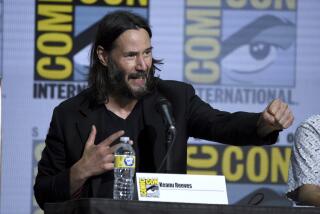Chasing Their Own Tales : THE OUROBOROS, <i> By Howard Coale (Ticknor & Fields: $19.95; 288 pp.)</i>
- Share via
As the world has tilted on its axis, Asia is increasingly the place where the young go off to find themselves, or lose themselves in love and life and art; the Far East has become the latest Land of Opportunity, for heart and soul and pocketbook. And doggedly shadowing life, the novels that once would have been set in Paris are more and more located in the disorienting Orient: Japan alone has been the setting for first novels by three distinguished young Americans--Jay McInerney, Brad Leithauser and John Burnham Schwartz--who tell of young men coming of age abroad, and putting together the pieces of their broken families across the International Date Line. Besides, venturing into a foreign darkness, where all certainties are turned on their heads and anything can happen, is the ultimate romantic experience: Resemblances to falling in love are scarcely coincidental.
The latest entry in this growing field is centered not on Japan but on the second-most-popular place for Americans to live and work in Asia--Taipei--and in it, being abroad and being at sea and being in love all come to seem interchangeable.
Young Harry, the protagonist of Howard Coale’s first novel, is a classic innocent abroad, a mad beast of blundering impulses who storms across the Far East like a bull in several china shops, not least the ones of his own imagination. Racing off to Taipei in pursuit of his American college girlfriend, he finds himself almost instantly out of his depth, left out of her conversations in Mandarin, unable to tell man from woman, or enemy from friend, surrounded by a swarm of indecipherable Chinese characters.
Descending ever deeper into political and romantic rivalries he cannot begin to fathom, and falling repeatedly on his face, Harry stumbles off to Hong Kong and ends up at last stalking his love--or himself, or enlightenment--in the snowy mountains of Nepal.
Coale’s writing is decidedly at its best when describing the exteriors of Harry’s world, and the exotic scenes that flash past in the background (Taipei “a smoggy little jewel of cement”; Hong Kong, from the harbor, “like a high, jagged set of false teeth coming out of the water”). The Taiwanese capital itself, forever brooding under heavy smog and bristling with secret energies, becomes as menacing and seductive as any Mata Hari. And Coale has considerable fun with the whole motley crowd of foreign vagabonds who assemble in the East, posing themselves against exotic backdrops quite as sedulously as any of the tourists they despise.
Harry, of course, is a prize specimen, a student who finds himself employed as a teacher, and a newcomer so innocent that he is always taken to be guilty. Around him, though, is a whole traveling company of archetypes: two serious Germans there to study sword-dancing, a Brit working on his alienation, an Italian playing the fledgling sex goddess and a terminally optimistic Aussie who cannot restrain himself from crying out lines such as, “What do you think Jesus would have thought about creative visualization?”
With so many Westerners in search of the mysterious East bumping into Easterners in search of the mysterious West, there is never any shortage of cross-cultural irony: When Harry tries to teach English to a Taiwanese government official, he finds himself obliged to describe, in Technicolor detail, a Hollywood he has never seen. His Chinese host, in turn, pulls out a Panasonic version of the I Ching. The central eponymous symbol of the book, whose meaning is everywhere apparent, is a supercomputer named after the mythical serpent that was said to consume its own tail.
“The Ouroboros” is very much a young man’s book, full of churning, naked emotion and page after page of anguished rumination on its beloved. Coale rarely uses one metaphor where two will do, and there are plenty of sentences such as “There was the pervasive aura of disheveled exhaustion in my bearing.”
Nevertheless, for all its fuzz-cheeked roughness, the narrative does pick up a crazy kind of hurtling intensity, and it quickens as it goes on, racing toward a dramatic climax, around the Monkey Temple in the shadow of Annapurna, in which all the foreigners unexpectedly reassemble, chasing their own tails with increasing ferocity, and realizing, of a sudden, in the high, clear air of the Himalayas, that they’ve traveled half-way around the world to find the very people they were trying to flee at home.
More to Read
Sign up for our Book Club newsletter
Get the latest news, events and more from the Los Angeles Times Book Club, and help us get L.A. reading and talking.
You may occasionally receive promotional content from the Los Angeles Times.









